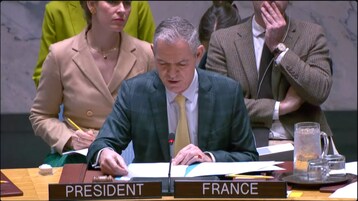-
Before it exits Philippines, typhoon Rai kills up to 31 people

The Xinhua reported that Acerns Velasco of Lapu-Lapu City in the central Philippines said in a Facebook post seven hours after Typhoon Rai slammed into the country on Thursday: "I can hear the strong wind, howling as it peels off the iron sheets of our house."
The strongest typhoon to batter the Philippines this year swelled rivers and flooded low-lying areas while cutting through towns and villages in the central Philippines and the northern Mindanao in the southern Philippines. The typhoon has killed up to 31 people.
Out of the 31 reported deaths, the National Disaster Risk Reduction and Management Council said only four have been validated. The national police reported at least 19 deaths but did not provide further details.
Gusty winds from the powerful typhoon toppled over trees and power lines in the Philippines as it blew away from the archipelago on Saturday.

Water was chest-high in some places, knee-high in others. Only roofs in some flooded areas remained visible, forcing rescuers to use rubber boats and ropes to evacuate people to safer grounds.
Typhoon Rai weakenes after slamming into southern and central parts of the Philippines
In Bohol, one of the hardest-hit provinces, some residents sat on the roofs of their flooded houses as they waited for rescuers. People in the affected areas have difficulty in contacting their relatives due to the cut of telecommunication and power lines.
Bohol Governor Arthur Yap lamented that the breakdown of communications makes it difficult to make a rapid assessment of the typhoon.
Yap said the local government has moved more than 13,000 families to evacuation centers from critical areas. He added: "But throughout the night and into yesterday morning, this number has swelled as the devastation was great and all-encompassing."
Yap said on Saturday that he had signed an executive order declaring a state of calamity in the entire province "due to the severity of destruction."
Dinagat Islands Governor Kaka Bag-ao said typhoon Rai "leveled (the island province) to the ground," cutting power and communication lines. Bag-ao said: "We have lost our homes. Wall and roofs were torn and blown away like paper."
Yellow warning for wind issued in Britain as storm hits parts of the country
Public work crews of the affected areas in the central and southern Philippines have worked hard to clear the roadways of fallen trees and debris, restore the power and communication lines.
Lawmaker Francisco Matugas from Surigao del Norte said almost all of Siargao Island's population, including tourists, experienced the fierce and destructive winds, adding that the island, a famous tourist destination for surfers, was "totally devastated."
Rai made landfall on the island on Thursday afternoon. It was blowing maximum winds of 195 km per hour and with gusts of up to 240 km per hour when it slammed into Siargao Island.
Assistant Secretary Jusan Vincent Arcena of the Presidential Communications Operations Office said his hometown Siargao "is unfortunately devastated by the typhoon."
Over 10,000 new Omicron cases found in UK
Arcena added in a Facebook post: "I'm worried about their safety. I can't even contact my relatives and local government units because of the situation here and in the island."
Landslides and flash floods are common across the Philippines during the rainy season, especially when typhoons hit.
The Philippines is one of the most disaster-prone countries in the world, mainly due to its location in the Pacific Ring of Fire and Pacific typhoon belt. On average, this archipelagic country experiences 20 typhoons every year, some of which are intense and destructive.
The World Bank said natural disasters have killed 33,000 Filipinos in the past thirty years, and 120 million people adversely affected.
Source: xinhua
You May Also Like
Popular Posts
Caricature
BENEFIT Sponsors BuildHer...
- April 23, 2025
BENEFIT, the Kingdom’s innovator and leading company in Fintech and electronic financial transactions service, has sponsored the BuildHer CityHack 2025 Hackathon, a two-day event spearheaded by the College of Engineering and Technology at the Royal University for Women (RUW).
Aimed at secondary school students, the event brought together a distinguished group of academic professionals and technology experts to mentor and inspire young participants.
More than 100 high school students from across the Kingdom of Bahrain took part in the hackathon, which featured an intensive programme of training workshops and hands-on sessions. These activities were tailored to enhance participants’ critical thinking, collaborative problem-solving, and team-building capabilities, while also encouraging the development of practical and sustainable solutions to contemporary challenges using modern technological tools.
BENEFIT’s Chief Executive Mr. Abdulwahed AlJanahi, commented: “Our support for this educational hackathon reflects our long-term strategic vision to nurture the talents of emerging national youth and empower the next generation of accomplished female leaders in technology. By fostering creativity and innovation, we aim to contribute meaningfully to Bahrain’s comprehensive development goals and align with the aspirations outlined in the Kingdom’s Vision 2030—an ambition in which BENEFIT plays a central role.”
Professor Riyadh Yousif Hamzah, President of the Royal University for Women, commented: “This initiative reflects our commitment to advancing women in STEM fields. We're cultivating a generation of creative, solution-driven female leaders who will drive national development. Our partnership with BENEFIT exemplifies the powerful synergy between academia and private sector in supporting educational innovation.”
Hanan Abdulla Hasan, Senior Manager, PR & Communication at BENEFIT, said: “We are honoured to collaborate with RUW in supporting this remarkable technology-focused event. It highlights our commitment to social responsibility, and our ongoing efforts to enhance the digital and innovation capabilities of young Bahraini women and foster their ability to harness technological tools in the service of a smarter, more sustainable future.”
For his part, Dr. Humam ElAgha, Acting Dean of the College of Engineering and Technology at the University, said: “BuildHer CityHack 2025 embodies our hands-on approach to education. By tackling real-world problems through creative thinking and sustainable solutions, we're preparing women to thrive in the knowledge economy – a cornerstone of the University's vision.”
opinion
Report
ads
Newsletter
Subscribe to our mailing list to get the new updates!






















